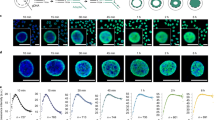Abstract.
A complex study of the spatial arrangement of different genetic elements (genes, centromeres and chromosomal domains) in the cell nucleus is presented and the principles of this arrangement are discussed. We show that the radial location of genetic elements in the three-dimensional (3D) space between the center of the nucleus and the nuclear membrane is element specific and dependent on the position of the element on the chromosome. In contrast, mutual angular positioning of both homologous and heterologous genetic elements is, in the majority of cases, random. In several cases, tethering of heterologous genetic elements was observed. This close proximity of specific loci may be responsible for their mutual rearrangement and the development of cancer. Comparison of our results with transcriptome maps shows that the nuclear location of chromosomal domains with highly expressed genes is more central when compared with chromosomes with low expression. The higher-order chromatin structure is strikingly similar in various human cell types, which correlates with the fact that the profiles of gene expression are also similar.
Similar content being viewed by others
Author information
Authors and Affiliations
Additional information
Electronic Publication
Rights and permissions
About this article
Cite this article
Kozubek, S., Lukásová, E., Jirsová, P. et al. 3D Structure of the human genome: order in randomness. Chromosoma 111, 321–331 (2002). https://doi.org/10.1007/s00412-002-0210-8
Received:
Revised:
Accepted:
Issue Date:
DOI: https://doi.org/10.1007/s00412-002-0210-8




